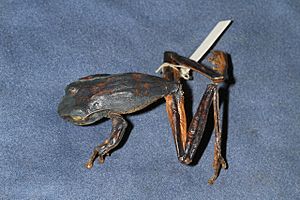Highland tree frog facts for kids
Quick facts for kids Highland tree frog |
|
|---|---|
 |
|
| Conservation status | |
| Scientific classification | |
| Synonyms | |
|
The highland tree frog (Litoria wollastoni) is a small frog that lives in New Guinea. Scientists believe this frog makes its home in the hills and lower parts of mountains. You can find it in both Indonesia and Papua New Guinea.
Scientists think the highland tree frog is related to another frog called the Litoria arfakiana.
Contents
About the Highland Tree Frog
The highland tree frog is a type of tree frog, which means it spends most of its life in trees or other plants. These frogs are usually small and have special pads on their toes. These pads help them grip onto leaves and branches, making them excellent climbers. They are often camouflaged, meaning their skin color helps them blend in with their surroundings. This helps them hide from predators and sneak up on their prey.
Where Highland Tree Frogs Live
Highland tree frogs live in tropical areas, specifically in the mountainous regions of New Guinea. This island has many different types of habitats, from dense rainforests to high mountain peaks. The frog prefers the cooler, wetter environments found in the hills and lower mountain slopes. These areas often have plenty of trees and plants, which are perfect for a tree frog. The climate in these regions is usually warm and humid, which is ideal for amphibians like frogs.
What Highland Tree Frogs Eat
Like most frogs, the highland tree frog is a carnivore, meaning it eats other animals. They mostly eat small insects and other tiny creatures. Their diet might include flies, mosquitoes, beetles, and spiders. Frogs are ambush predators. This means they wait patiently for their prey to come close. Then, they quickly flick out their long, sticky tongue to catch the insect. This happens so fast that it's hard to see!
Life Cycle and Reproduction
The life cycle of a frog is fascinating. It usually starts with eggs laid in water. Female highland tree frogs likely lay their eggs in small pools, puddles, or even in water collected in plants. These eggs hatch into tiny creatures called tadpoles. Tadpoles live in the water and breathe using gills, much like fish. They mostly eat algae and other plant matter.
As tadpoles grow, they begin to change. This process is called metamorphosis. They start to grow legs, their tails get shorter, and their gills are replaced by lungs. Eventually, they leave the water and become young frogs. These young frogs look like smaller versions of the adults. They then move onto land and begin their adult lives, hunting insects and living in the trees.
Conservation Status
The highland tree frog is listed as "Least Concern" by the IUCN Red List. This means that, for now, scientists believe its population is stable and not in immediate danger of disappearing. However, it's always important to protect natural habitats. Changes to their environment, like deforestation or climate change, could affect these frogs in the future. Protecting their homes helps ensure these unique creatures continue to thrive.
See also
 In Spanish: Litoria wollastoni para niños
In Spanish: Litoria wollastoni para niños


